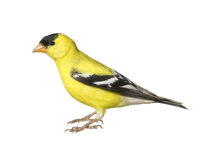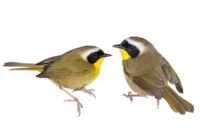Migrating Songbirds are Coming to a Sky Near You

By Ilene Dube
In J.D. Salinger’s 1951 bildungsroman The Catcher in the Rye, narrator Holden Caulfield obsesses over where the ducks in the Central Park Lake go in winter. They fly south for the winter, a taxi driver tells him.
Not necessarily, according to the park’s website. “The answer is that most stay put in Central Park, while some will migrate south during the winter months. It is not unusual to see them huddled together around the various bodies of water in the park.”

shutterstock.com
With avian migration, it’s complicated. Birds migrate primarily for food and nesting locations. In the Northern Hemisphere, they migrate north in spring for insects, plants, and an abundance of nesting locations. As winter approaches and the availability of insects and other food drops, the birds move south again. Just as with some humans, escaping the cold can be a motivating factor, but many species, including hummingbirds, can withstand freezing temperatures if an adequate supply of food is available.
“Every hour of every day, somewhere, some place, animals are on the move — flying, walking, swimming, or slithering from one destination to another,” writes Princeton Professor of Ecology, Evolutionary Biology, and Public Affairs David Wilcove in his 2008 book The Way Home: The Decline of the World’s Great Animal Migrations. “Cole Porter was right. Birds do it. Bees do it. Even educated fleas do it.”

American Goldfinch
The journeys are among the greatest miracles. Arctic terns migrate from nesting grounds in the Bering Sea to the Antarctic Ocean, “a circumpolar voyage that is without equal in the animal kingdom,” writes Wilcove.
The Atlantic Flyway migration route follows the Atlantic coast and the Appalachian Mountain range, giving Garden State residents a front-row seat as hundreds of species head south in fall.
In the next couple of weeks, raptors — especially hawks, falcons, and eagles — will pass through New Jersey on their southward migration, according to the New Jersey Conservation Foundation. “They conserve energy as they follow our state’s mountain ridges and coastline, taking advantage of thermals, wind currents, and updrafts.
“And this is just the beginning! New Jersey’s fall bird migration is an amazing spectacle that runs through November.”
New Jersey Audubon Birding Ambassador Pete Dunne points out that while November and December are “migratory prime time” for some species of raptors and water birds, migration continues until February. “Blanketing snow is another migratory trigger,” he writes. “You can’t catch what you can’t see, and when rodents lie under an eye-defeating blanket of snow, rodent-eating raptors must travel on or go hungry.”

Blue Grosbeak
The strategy for many birds is to migrate just far enough south to ensure survival, but get a head start on the competition come spring, continues Dunne, the author of 16 bird books and a founder of the Cape May Hawkwatch. Dunne also created the World Series of Birding, a competition held once a year.
“It’s a gamble,” he writes. “Belted kingfishers and great blue herons play this game. If the winter is mild and they maintain access to open fish bearing water, they win. If a prolonged freeze grips the region, they lose. Most of these envelope pushers can survive several days of freeze but without food in the gizzard, their primary defense against winter cold diminishes. It’s all about food and access. Winter is a genetic culling device. It helps ensure only those hardy birds that play a winning hand survive to pass those genes on.”
Remember Winged Migration, the 2001 nearly wordless paean to the beauty of birds in flight? Filmmaker Jacques Perrin reminds us more than once that migration isn’t a mystical spiritual pilgrimage but a matter of survival, and during migration many of the birds die. “Their flight is a fight for life,” he says.
While mesmerized by the grace, beauty, and choreography of birds in flight, humans can be a destructive interloper. Bird populations have dropped by nearly 3 billion since the 1970s, and the 350 species of North American birds that migrate in autumn are facing increasing threats. Climate change, habitat loss, storms, feral cats and other predators, pesticides, and collisions with buildings further complicate the flights of migrating birds.

Eastern Towhee

Common Yellowthroat Warbler
In Princeton, the 39-acre Charles H. Rogers Wildlife Refuge bordering the Institute Woods used to be a spring mecca for warblers and other spring migrators, but due to deer browsing and habitat destruction by development, numbers are down. Invasive birds, such as grackles and starlings, make it harder for migrators to get the resources they need.
Deforestation in Borneo, due to the harvesting of palm oil, among other things, also effects the bird population migrating through New Jersey, according to Thomas Southerland, who played a key role in establishing the Refuge. Without the large blocks of inter-connected forest, hundreds of species could become extinct. Southerland cites research by Princeton University’s Wilcove on how climate change and the fragmenting of the forest negatively effects animal migration.
Wilcove’s newest research may help conservation efforts by alleviating some of these challenges. The study, published in Proceedings of the National Academy of Sciences, found that a network of protected forested land distributed across the eastern U.S. is key to maintaining healthy populations of migratory land birds.
“This is the first time we’ve had a comprehensive picture of where songbirds are stopping over for the entirety of the eastern United States,” says Wilcove. “It gives us a powerful new tool for identifying the key habitats these birds are using during their epic migrations.”
The researchers — Fengyi Guo, Jeffrey Buler, Jaclyn Smolinsky, and Wilcove — mapped stopover density of land birds during autumn migration for the eastern United States using radar data. “At a coarse scale, we found that birds migrate across a relatively broad front, underscoring the importance of widespread, locally based conservation efforts,” they say. “At finer scales, we identified stopover hotspots that consistently support high densities of migrants. We demonstrate that forests provide the most important habitats for autumn migrants and that deciduous forest fragments in heavily deforested regions support especially high densities of migrants. We also present evidence that the now-agriculture-dominated Midwest constitutes an inland migration barrier for forest birds.”
The authors urge the protection of broadleaf forests, especially the remaining forests in the agriculturally dominated Midwest. Locally based conservation efforts across the eastern U.S. will be key to protecting bird species along their migratory journeys.
“Pick the right night and you will hear them,” writes Wilcove. “A September night, perhaps, when a northwest wind has swept the clouds from the sky and the stars are out in full force. As midnight approaches, find a quiet spot away from the rumbles and groans of urban life and listen carefully. Soon you will hear soft chirps and whistles drifting down from the sky. These are the calls of migrating songbirds. A thousand feet above you, extending for hundreds of miles in all directions, is a vast highway of little birds heading south.… The sky is alive.”






